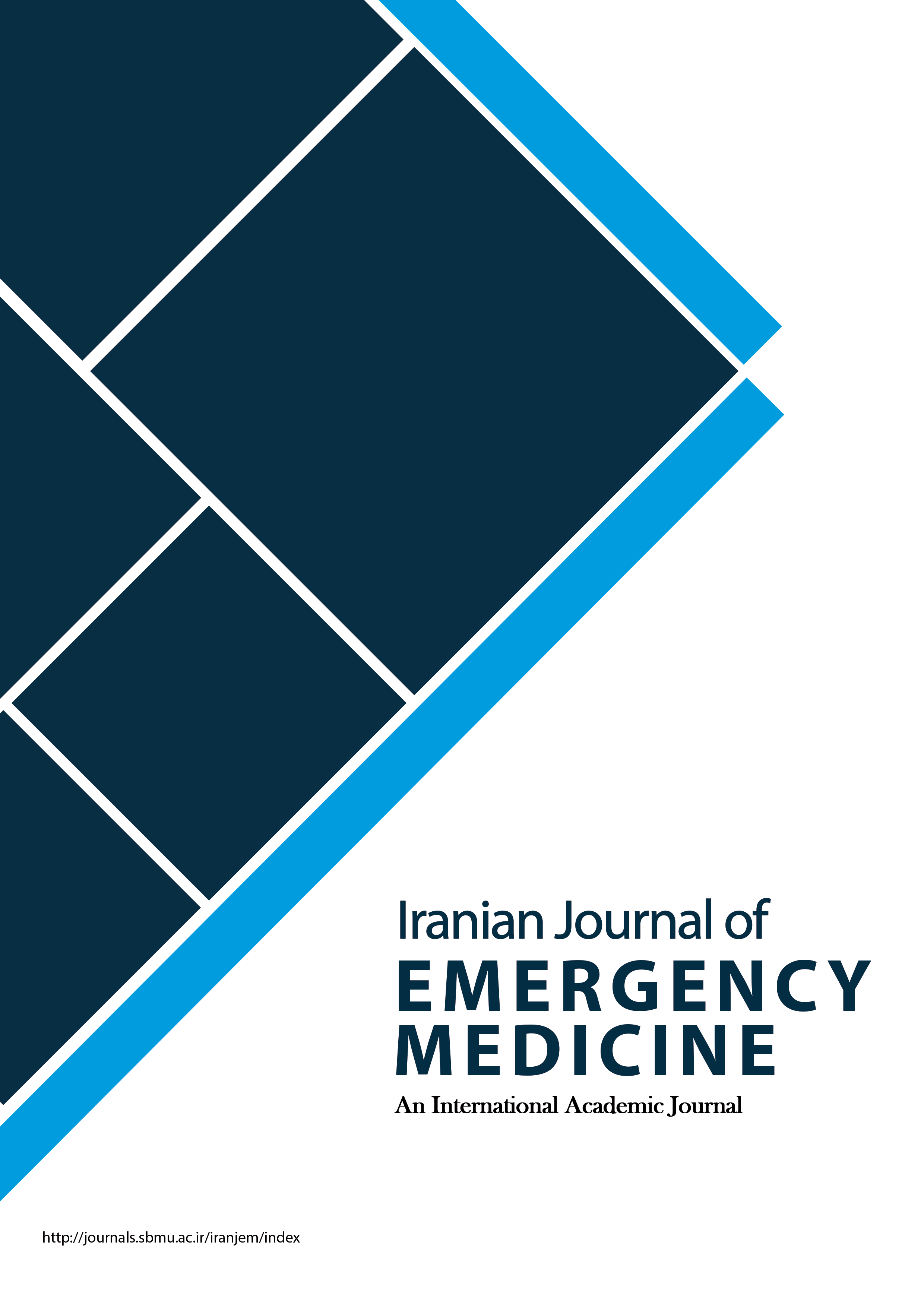Measuring Fibrinogen Level in Patients with Pelvic Trauma
Iranian Journal of Emergency Medicine,
Vol. 4 No. 4 (2017),
8 October 2017
,
Page 145-143
https://doi.org/10.22037/ijem.v2i1.18586
Abstract
Pelvic fracture is the second most common cause of death in trauma patients after head trauma; and the major reason for death in these patients is hemorrhage and its resulting hypovolemic shock. Rapid and proper diagnosis and treatment can improve the outcome of these patients. The main treatment consists of fixation of the pelvis and resuscitation of patient’s hemodynamic using isotonic liquids and blood products until the condition is favorable for surgery or angiography. New findings show that fibrinogen plays a vital role in reaching and maintaining homeostasis, especially in patients that have lost a significant amount of blood. It seems that concentration of plasma fibrinogen, which is a key glycoprotein in the coagulation cascade, is independently related to hemorrhage and prophylaxis infusion of fibrinogen concentrate can decrease bleeding. Fibrinogen level has been introduced as a determining factor in prediction of 28-day mortality of patients with heavy traumatic bleeding. Compared to fresh frozen plasma (FFP), injection of fibrinogen concentrate has had better results in improvement of outcome and has decreased need for other blood components and has led to an increased probability of survival without increasing the risk of venous thromboembolism. A study in 2015 showed that 19.2% of the patients with severe hemorrhage due to trauma had a fibrinogen level less than 2gr/L.
Writers of the current letter evaluated 60 patients with traumatic pelvic fracture with the mean age of 51.12 ± 20.30 years (11-85) (58.30% male). 42 (70.0%) cases had presented with 1-sided or double sided ramus fracture, 17 (28.3%) cases with iliac wing fracture and 1 (1.7%) case with acetabulum fracture. 16.7% of the patients had a hemoglobin level less than 10 mg/dL and 21.7% had systolic blood pressure less than 90 mmHg on admission to emergency department. Mean blood level of fibrinogen in this group of patients was 261.85 ± 40.24 mg/dL (200-368). In other words, considering the normal range described for the kit used for this study (Mahsa Yaran Company, Iran) none of the patients were in the hypofibrinogenemia zone (< 200 mg/dL). It seems that variables such as trauma severity, racial characteristics, underlying illnesses, hemorrhage severity, type of fracture, and … might also affect the level of plasma fibrinogen and its decrease following hemorrhage. Overall, a final decision regarding the effect of fibrinogen injection instead of products such as FFP requires further studies with higher accuracy and considering other factors affecting the outcome of such patients. However, considering the studies that affirm the role of fibrinogen in improving the outcome of patients with severe hemorrhage, it seems that measuring plasma fibrinogen level and injecting it for patients with hypofibrinogenemia is a wise solution in management of this type of patients.How to Cite
References
Hardy J-F, de Moerloose P, Samama CM. Massive transfusion and coagulopathy: pathophysiology and implications for clinical management. Canadian Journal of Anesthesia. 2006;53(2):S40.
Spahn D, Rossaint R. Coagulopathy and blood component transfusion in trauma. British journal of anaesthesia. 2005;95(2):130-9.
Hiippala ST, Myllyla GJ, Vahtera EM. Hemostatic factors and replacement of major blood loss with plasma-poor red cell concentrates. Anesthesia & Analgesia. 1995;81(2):360-5.
Karlsson M, Ternström L, Hyllner M, Baghaei F, Flinck A, Skrtic S, et al. Prophylactic fibrinogen infusion reduces bleeding after coronary artery bypass surgery-A prospective randomised pilot study. Thrombosis and haemostasis. 2009;102(1):137-44.
Rahe-Meyer N, Pichlmaier M, Haverich A, Solomon C, Winterhalter M, Piepenbrock S, et al. Bleeding management with fibrinogen concentrate targeting a high-normal plasma fibrinogen level: a pilot study. British journal of anaesthesia. 2009;102(6):785-92.
Rourke C, Curry N, Khan S, Taylor R, Raza I, Davenport R, et al. Fibrinogen levels during trauma hemorrhage, response to replacement therapy, and association with patient outcomes. Journal of Thrombosis and Haemostasis. 2012;10(7):1342-51.
Ozier Y, Hunt B. Fibrinogen concentrate for management of bleeding: against indiscriminate use. Journal of Thrombosis and Haemostasis. 2011;9(1):6-8.
Spahn DR, Bouillon B, Cerny V, Coats TJ, Duranteau J, Fernández-Mondéjar E, et al. Management of bleeding and coagulopathy following major trauma: an updated European guideline. Critical care. 2013;17(2):R76.
Aubron C, Reade M, Fraser J, Cooper D. Efficacy and safety of fibrinogen concentrate in trauma patients—a systematic review. Journal of critical care. 2014;29(3):471. e11-. e17.
Maegele M, Zinser M, Schlimp C, Schöchl H, Fries D. Injectable hemostatic adjuncts in trauma: fibrinogen and the FIinTIC study. Journal of Trauma and Acute Care Surgery. 2015;78(6):S76-S82.
- Abstract Viewed: 6842 times
- PDF (فارسی) Downloaded: 339 times
- HTML (فارسی) Downloaded: 136 times



